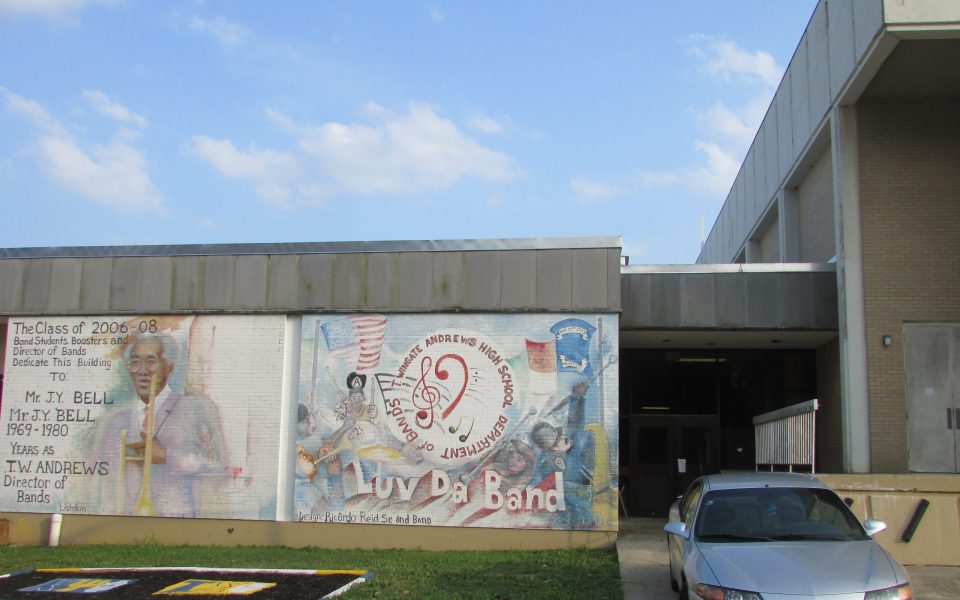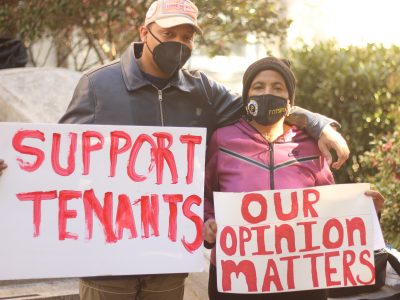by Jordan Green
The loss of a popular principal underscores the anxiety supporters of Andrews High School feel about their school’s declining enrollment and increasingly segregated student body.
Andrews High School is a story of integration in North Carolina, and its disintegration.
Built in 1968, Andrews High School was among the first high schools to be designed as a fully integrated facility in the state.
Split roughly 50-50 between black and white students when it opened, Andrews was the city’s middle-class high school. It absorbed most of the African-American students from William Penn High School, the all-black school that had recently closed. The High Point School Board — school districts across Guilford County would not merge until decades later — had initially favored a white candidate for principal, recalled Mike McDowell, who played on the school’s state championship football team in 1972, but the parents rallied behind Samuel Burford, who had served as principal at William Penn High School.
“He united the black and white community,” McDowell said.
Many of the white students chose to attend High Point Central High School because of its status as the established school, McDowell said, including most of the top-echelon white athletes. Central also absorbed some of the city’s poorest residents from the southwest quadrant, resulting in a student body polarized between the very wealthy and very poor. The two schools’ football teams were not allowed to compete until 1971.
Andrews won that game.
“There were 10,000 people there,” McDowell recalled. “I was a junior on the team and remember it like it was yesterday. Central had a phenomenal team. My senior year the two High Point schools almost played each other in the 4A state championship, but Central missed it by just one play. That shows the caliber of the teams. That was a blip for Central. They had a few more good years. Andrews won it again in ’76, and they were playing deep into the playoffs every year. That went on through the 1990s.”
The school’s early history supports the nearly fanatical pride of its alumni, who call themselves Red Raiders.
“Andrews was a great school the first 15 years,” McDowell said. “They probably won more state championships than any other school in North Carolina. It wasn’t just athletics. The debate team went to national championships. The band was phenomenal. They were in the Cotton Bowl parade. They went to the Macy’s Day parade. They entertained at Appalachian State. The era that we were in they excelled at everything.”
From McDowell’s perspective, Central’s boosters have been eager to poach Andrew’s best students since they realized the initial plan to split Central’s student body between rich and poor. They finally accomplished their goal in 2000 when the consolidated school board redrew attendance lines, shifting students in the middle-class neighborhoods of Oak View and Shadybrook from Andrews to Central. Meanwhile, McDowell said, the plan moved most of the students from the city’s public housing community to Andrews, along with two wealthy neighborhoods in the Skeet Club Road area that had previously been assigned to Southwest High School. The decision caused an uproar among parents in the Skeet Club Road, who recoiled at the notion of their children being bused across town to a poorer school.
“At Andrews we don’t look at black and white; we look at it as Red Raiders,” said the Rev. J. Robert Murphey, an alum who has worked with Andrews athletics since 1996, announcing football and basketball games. “When I was there it was 55 percent black and 45 percent white. Now, it’s turned into a segregated school, and that’s healthy for nobody.”
Andrews’ student population has become less diverse while overall enrollment has dropped over the past 10 years. Referring to stats provided by the school district, Murphey said the school had 811 black students and 291 white students out of a total enrollment of 1,199 in the 2004-2005 school year. In the school year that just ended, he said there were 642 black students and 90 white students out of a total enrollment of 867. Many of the white students have transferred out of Andrews to attend the Penn-Griffith School for the Arts, the international baccalaureate program at Central or Southwest High School, Murphey said.
“There’s a lot of diversity in the Andrews zone,” Murphey said. “If you’ve gone from 291 to 90 white students, then where are they? The numbers would tell you they’ve been reassigned.”
Recent turnover in school leadership in High Point has exposed the longstanding rivalry between Andrews and Central, with parents, boosters and alumni from both schools experiencing vulnerability. Principals at both high schools have recently left, along with top administrators at Scale School, Southwest Middle School, Johnson Street Elementary and Montlieu Elementary, said Guilford County School Board member Ed Price, who represents District 2 in High Point.
“Better jobs within the system and better jobs outside the system is the simplest way to put it,” Price said, by way of explanation for the defections. He said he had been fielding phone calls from concerned parents all day on Monday, mainly from parents at Central and Andrews. Price attended Central, while his wife and three children attended Andrews.
Bob Christina was a popular principal at Central, Price said, and many parents want the district to find a way to bring him back.
“He was the second lowest paid principal of our normal high schools,” Price said. “It was just a matter of time before someone was going to hire him away. He was excellent. I’ve been telling administration for months that he’s going to leave. It’s frustrating.”
Price met with parents at Central on June 30, along with Mayor Bill Bencini, Guilford County Commission Chair Hank Henning and school board member Keith McCullough, who represents District 1. Price said Bencini and Henning attended the meeting at his request.
“I wanted them to reassure the parents that everything’s a go as far as the $12 million in renovations,” he said. “The school is getting a new cafeteria, a new library and media center, and there are major renovations on that beautiful auditorium.”
On Tuesday, it was Andrews’ turn. A public forum hosted by the school district was scheduled for that evening in response to concerns raised by alumni and other members of the school community.
Like their counterparts at Central, the parents and boosters at Andrews are chafing at the loss of a highly regarded school leader. Their former principal, Rodney Wilds, was reassigned to Dudley High School in Greensboro. Wilds led Andrews for six years, following a succession of four principals at the school from 2003 to 2009.
“Mr. Wilds brought stability, but he’s taken out and sent to Dudley,” said Murphey, the basketball announcer. “Dudley was in the same position as us. They were worried about instability at Dudley, so they took our strong leader and gave him to Dudley. Mr. Wilds graduated from Dudley, so they felt like he could bring a real vision to the school.”
Many Andrews parents, alumni and boosters would have preferred a new principal with preexisting ties to the school, although Murphey acknowledged that Wilds himself came to the school as an outsider.
“I think the reason right now is that it would have helped to have someone with Andrews ties because of the struggles with the school,” Murphey said. “If you don’t extremely love the school, then it’s going to be very difficult in its current condition to stay very long.”
On May 29, the district announced the appointment of David Miller, formerly the principal at the Academy at Smith High School in Greensboro, to fill the top job at Andrews. Given the school’s current challenges, many boosters are reflexively turning to tradition.
While parents and boosters were expected to vent their frustration at school officials on Tuesday, many have already come to terms with the decision and are backing Miller to give him every opportunity to succeed.
Murphey said despite initial hopes that the new principal would be a person with pre-existing ties to the community, alumni are now fully supporting Miller and appreciate that he has reached out to them.
“This is no slight to the new guy that’s coming,” McDowell said. “I think the Andrews community would like to see the same thing that High Point Central has asked for and that Dudley has got — that they get someone who is familiar with the Andrews community who said, ‘I know how to make this school great.’”
Join the First Amendment Society, a membership that goes directly to funding TCB‘s newsroom.
We believe that reporting can save the world.
The TCB First Amendment Society recognizes the vital role of a free, unfettered press with a bundling of local experiences designed to build community, and unique engagements with our newsroom that will help you understand, and shape, local journalism’s critical role in uplifting the people in our cities.
All revenue goes directly into the newsroom as reporters’ salaries and freelance commissions.





Leave a Reply